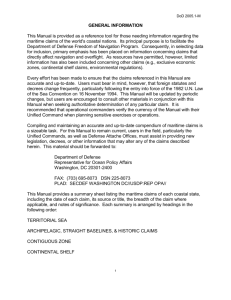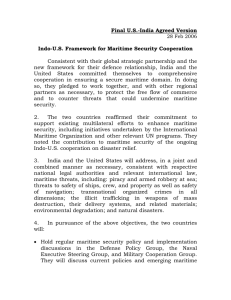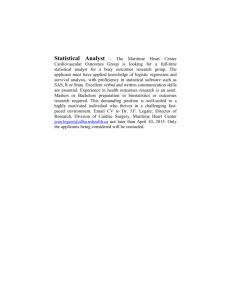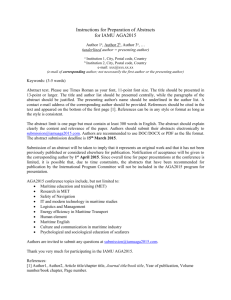The RAND Corporation is a nonprofit institution that research and analysis.
advertisement
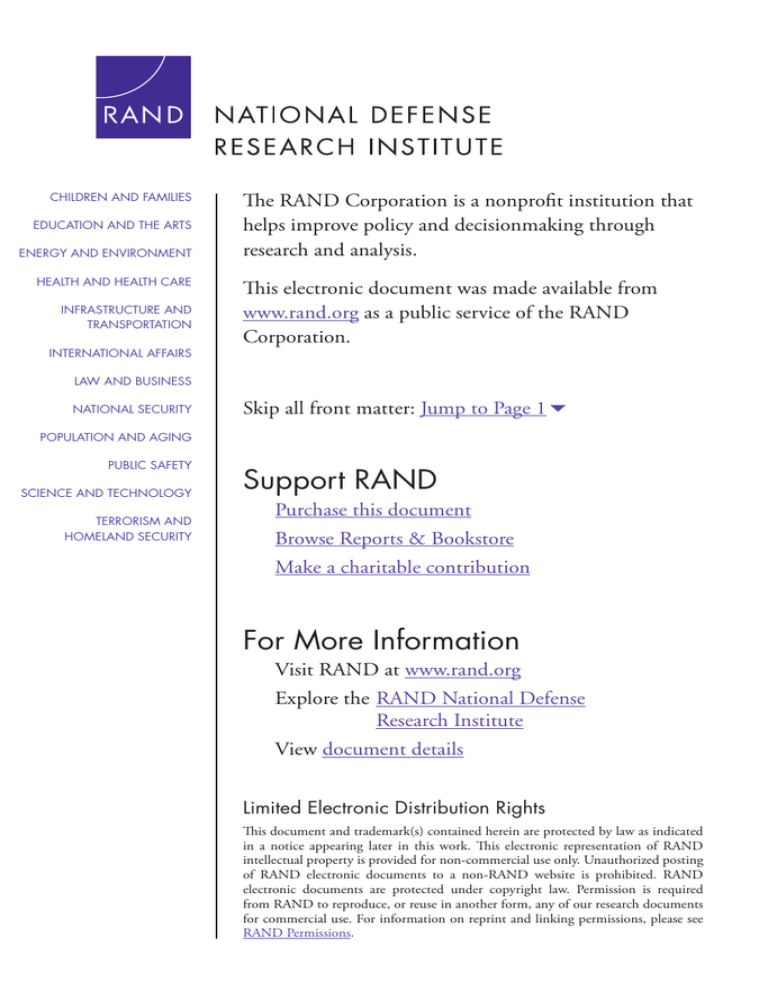
CHILDREN AND FAMILIES EDUCATION AND THE ARTS ENERGY AND ENVIRONMENT HEALTH AND HEALTH CARE INFRASTRUCTURE AND TRANSPORTATION INTERNATIONAL AFFAIRS The RAND Corporation is a nonprofit institution that helps improve policy and decisionmaking through research and analysis. This electronic document was made available from www.rand.org as a public service of the RAND Corporation. LAW AND BUSINESS NATIONAL SECURITY Skip all front matter: Jump to Page 16 POPULATION AND AGING PUBLIC SAFETY SCIENCE AND TECHNOLOGY TERRORISM AND HOMELAND SECURITY Support RAND Purchase this document Browse Reports & Bookstore Make a charitable contribution For More Information Visit RAND at www.rand.org Explore theRAND National Defense Research Institute View document details Limited Electronic Distribution Rights This document and trademark(s) contained herein are protected by law as indicated in a notice appearing later in this work. This electronic representation of RAND intellectual property is provided for non-commercial use only. Unauthorized posting of RAND electronic documents to a non-RAND website is prohibited. RAND electronic documents are protected under copyright law. Permission is required from RAND to reproduce, or reuse in another form, any of our research documents for commercial use. For information on reprint and linking permissions, please see RAND Permissions. This product is part of the RAND Corporation monograph series. RAND monographs present major research findings that address the challenges facing the public and private sectors. All RAND monographs undergo rigorous peer review to ensure high standards for research quality and objectivity. Characterizing and Exploring the Implications of Maritime Irregular Warfare MOLLY Dunigan | Dick Hoffmann Peter Chalk | Brian Nichiporuk | Paul DeLuca Prepared for the United States Navy Approved for public release; distribution unlimited NAT IONAL DEFENS E RES EA RC H I NS TI TUTE The research described in this report was prepared for the United States Navy. The research was conducted within the RAND National Defense Research Institute, a federally funded research and development center sponsored by the Office of the Secretary of Defense, the Joint Staff, the Unified Combatant Commands, the Navy, the Marine Corps, the defense agencies, and the defense Intelligence Community under Contract W74V8H-06-C-0002. Library of Congress Cataloging-in-Publication Data Characterizing and exploring the implications of maritime irregular warfare / Molly Dunigan ... [et al.]. p. cm. Includes bibliographical references. ISBN 978-0-8330-5891-1 (pbk. : alk. paper) 1. Naval art and science. 2. Irregular warfare—United States—Case studies. 3. Riverine operations—United States—Case studies. 4. Piracy—Prevention—Case studies. 5. Maritime terrorism—Prevention—Case studies. I. Dunigan, Molly. V103.C44 2012 359.4'2—dc23 2012002819 The RAND Corporation is a nonprofit institution that helps improve policy and decisionmaking through research and analysis. R AND’s publications do not necessarily reflect the opinions of its research clients and sponsors. R® is a registered trademark. Cover photos: (top) U.S. Navy photo; (bottom) Crown Copyright/UK Ministry of Defence, used in accordance with the Open Government License. © Copyright 2012 RAND Corporation Permission is given to duplicate this document for personal use only, as long as it is unaltered and complete. Copies may not be duplicated for commercial purposes. Unauthorized posting of RAND documents to a non-RAND website is prohibited. RAND documents are protected under copyright law. For information on reprint and linking permissions, please visit the R AND permissions page (http://www.rand.org/publications/ permissions.html). Published 2012 by the RAND Corporation 1776 Main Street, P.O. Box 2138, Santa Monica, CA 90407-2138 1200 South Hayes Street, Arlington, VA 22202-5050 4570 Fifth Avenue, Suite 600, Pittsburgh, PA 15213-2665 RAND URL: http://www.rand.org To order RAND documents or to obtain additional information, contact Distribution Services: Telephone: (310) 451-7002; Fax: (310) 451-6915; Email: order@rand.org Summary Given U.S. involvement in and support for multiple counterinsurgency (COIN) and counterterrorism (CT) campaigns in various theaters, particularly over the past decade, the concept of irregular warfare has become increasingly prevalent among defense strategists and analysts (HQDA, 1961, 2006, 2008; U.S. Joint Chiefs of Staff, 2008; Newton et al., 2009). Irregular warfare (IW) includes many more activities than just COIN and CT, and, despite the fact that some of these campaigns are occurring or have occurred in maritime environments, current conceptions of irregular warfare do not focus on the specific requirements and opportunities related to conducting IW in the maritime realm (Mullins, undated).1 While we recognize that ground forces carry out the bulk of irregular warfare activities, the purpose of this analysis is to describe the strategic potential of maritime irregular warfare (MIW) and to assess its operational and tactical characteristics based on a sample of recent MIW operations. In doing so, we aim to inform future U.S. investments in force structure and future IW doctrine regarding the maritime aspects of IW and how they fit with other IW domains. Although maritime forces are often employed primarily in support of ground operations, our research shows that—in environments with a maritime component—maritime operations tend to have a noticeable comparative advantage over land-based operations in terms of mobility and can involve a smaller or less visible footprint in a host nation. Thus, 1 This is true even of the Navy Irregular Warfare Office’s definition of the term. xi xii Characterizing and Exploring the Implications of Maritime Irregular Warfare the conceptions of IW, which do not currently include a prominent maritime component, could benefit from increased recognition of the unique contributions that maritime operations could make to overall IW campaigns. The potential for maritime operations to play a role in IW campaigns raises the question of which maritime operational activities might be most relevant in the IW context and, furthermore, what implications such operations might have for the overall strategic environment and force structure. Guided by these questions, this monograph defines MIW in relation to IW doctrine and identifies the actors and tactics involved in a range of cases. It also provides a detailed analysis of a sample of historical and current MIW activities from both a friendly and enemy viewpoint. What Is Maritime Irregular Warfare? Based on our doctrinal and case-study analyses, we define MIW as operations involving at least one irregular actor or tactic that aim to shape the maritime environment in at least one of three ways: (1) to prevent supplies or personnel support from reaching an adversary, (2) to increase the capacity of partner naval and maritime forces, or (3) to project tailored U.S. power ashore to directly confront adversary forces, when necessary. Building on this definition, we also identify three types of operational activities conducted in MIW, as shown in Figure S.1: external operations, building partner capacity, and internal operations. Finally, we identify a spectrum of strategic scenarios in which MIW tends to occur. This spectrum ranges from law enforcement scenarios, such as counterpiracy (CP) or counternarcotics (CN) campaigns, to unconventional warfare (UW) and COIN. Summary xiii Figure S.1 The Range of MIW Operational Activities External operations (ISR, isolate, contain) Least direct involvement with the population Enemy forces Host-nation (partner) forces Build partner capacity (train, equip, advise) Internal operations (special reconnaissance, strikes, raids) U.S. forces Most direct involvement NOTE: ISR = intelligence, surveillance, and reconnaissance. RAND MG1127-S.1 Maritime Irregular Warfare Case Studies Operation Enduring Freedom–Philippines (OEF-P), in which the U.S. force has been limited to 600 personnel in the joint operations area, served as a benchmark case of MIW in our study for several reasons. Of primary importance for this analysis, the operation is being conducted in an archipelago environment, in which we would expect maritime forces to play a large role, and includes, to some extent, irregular forces and tactics on both sides of the conflict. Moreover, the enemy in this case (Abu Sayyaf) utilizes maritime methods to a significant extent. Thus, the operation appears on the surface to be a model case of maritime irregular warfare. Finally, the operation is largely considered a successful case of irregular COIN and CT warfare conducted xiv Characterizing and Exploring the Implications of Maritime Irregular Warfare by U.S. forces. Upon closer examination, the OEF-P case reflects the strategic, operational, and tactical challenges of MIW as well as its potential benefits. This study compared and contrasted the OEF-P case with several historical cases of MIW spanning the range of strategic scenarios in which MIW tends to occur in an effort to determine the extent to which the lessons of OEF-P are generalizable. Other historical cases examined included MIW operations during the Vietnam War (an example of COIN), ongoing MIW CN/CT operations in Colombia and counterpiracy operations off the Horn of Africa (HoA) (both examples of law enforcement-related operations), and the covert U.S. mining of Nicaraguan ports and harbors in the early 1980s (an example of UW).2 The study also examined several cases illustrating the breadth of capabilities possessed by adversaries or analogous actors in the recent past and in current operations. While the future is uncertain regarding the range of potential MIW threats that the United States may confront, we found this exercise useful in clarifying the spectrum of possible future irregular threats that the United States may confront in the maritime environment. The Colombia case provides some insight into the issue of potential future threats, as do the cases of the Sea Tigers (the maritime wing of the Liberation Tigers of Tamil Eelam, or LTTE) active in Sri Lanka from 1984 through 2009, the Lashkar-e-Taiba (LeT) attack on Mumbai in 2008, and piracy in the HoA over the past decade. While the LTTE, LeT, and HoA pirates are not all direct adversaries of the United States at present, they can inform future U.S. approaches to MIW threats. Taken together, these cases paint a picture 2 While the lessons of the Nicaragua case are useful, one should exercise caution in generalizing from this case study to other cases of maritime unconventional warfare. This case is unique in that the U.S. partner (the Contras) was aware of the mining operations only after the fact, and CIA-hired contractors—rather than U.S. military or partner forces— conducted the operations assessed here. We nonetheless consider this a case of unconventional warfare due to the fact that the United States was engaged in a broader UW mission to support the Contras during this period, and the maritime operations were a component of a broader strategy aimed specifically at establishing conditions for the partner forces to succeed. Other cases of UW operations in the maritime realm might lead to different findings, however. Analyses of such cases would therefore pose a fruitful avenue for future research. Summary xv of current and potential future MIW adversaries who possess a vast range in technical capability but are often well organized, employ successful recruitment tactics, and are quite adept at intelligence, surveillance, and reconnaissance. Findings and Recommendations U.S. and Partner Capabilities The study’s main findings span the strategic, operational, and tactical levels. Several are specific to MIW, while others have implications both for MIW and for IW operations more broadly. First, the maritime force is generally considered to play a supportive role to ground forces in IW and therefore has the potential to be underutilized even in IW operations conducted in a predominantly maritime environment. Because much IW takes place on land and is conducted by ground forces, maritime forces often play a largely supportive role in land-based IW operations. This is true even in maritime environments, such as the Philippine archipelago. Therefore, policymakers and military planners should weigh the costs and benefits of land-based versus maritime operations in each IW situation and make balanced assessments regarding the extent to which each option provides a viable solution on its own and in combination with other options. It is also relevant to note, from a tactical planning perspective, that maritime forces sometimes conduct IW operations in nontraditional environments (such as on land) and perform nontraditional functions (such as leading provincial reconstruction teams and building schools). This has occurred in Colombia, Operation Iraqi Freedom, and Operation Enduring Freedom in Afghanistan. Conversely, ground-based forces sometimes conduct maritime operations in IW campaigns, as was seen in Vietnam. Moreover, the Vietnam case illustrates that riverine MIW can benefit from a combined-arms approach, so it is sensible to consider how maritime and ground-based forces can be used in tandem to conduct MIW operations. Second, countries that have a prevalent maritime dimension associated with an insurgency could potentially benefit from the enhancement xvi Characterizing and Exploring the Implications of Maritime Irregular Warfare of civil-military operations (CMOs) in the maritime arena. The Vietnam experience shows that in riverine COIN—just as in land-based COIN—strike operations against the main insurgent units should be followed up by efforts to enhance local public support if final victory is to be achieved; CMOs provide one potential mechanism for enhancing public support. Such operations might, for instance, aim to revitalize ports and harbors in areas that are largely economically dependent on fishing. They have also been conducted to some extent in OEF-P, but land-based efforts have thus far been the focus of CMOs in that largely maritime environment. Third, maritime operations in IW can allow the United States to scale its ground involvement in useful ways. Because MIW capabilities often allow U.S. forces to operate with relatively high mobility, low visibility, and a small footprint, maritime forces offer a military option when host-nation sensitivities or U.S. preferences constrain the deployment of U.S. ground forces. For example, sea-based forces in the Sulu Archipelago are more mobile, responsive, and capable of supporting Armed Forces of the Philippines (AFP) missions across larger coastal areas of the archipelago than are land-based special forces teams. Fourth, if one assumes that future MIW engagements that entail building a partner’s capacity will resemble OEF-P, it is important to manage strategic expectations based on realistic assessments of the partner’s capabilities. By properly scaling U.S. efforts in a way that ensured that the AFP remained in the lead while also ensuring its success, the IW campaign in OEF-P has encouraged development and promoted the AFP’s legitimacy among the Filipino population. The personnel limits and other constraints placed on U.S. forces in OEF-P are argued to be one reason that the Philippines is investing more in its navy and developing practical new capabilities for the Sulu Archipelago, such as the Coast Watch South coastal surveillance system paired with additional combatant craft. Yet, scaling U.S. activities and strategic expectations in this manner can be challenging, particularly when U.S. forces must limit their own activities and sacrifice short-term effectiveness for longterm partner viability. Fifth, when building partner capacity, either in MIW or land-based IW, the United States should make efforts to provide equipment and tech- Summary xvii nology that the partner will be able to maintain and operate without difficulty. This lesson is particularly evident in the OEF-P case. Because of the Philippines’ minimal military-industrial infrastructure and its navy’s small training budgets, U.S. forces need to pass along equipment and teach tactics that are low-tech, low-cost, practical, reliable, and easy to maintain. Another equipment-related problem in the context of building partner capacity has been evident in the United States’ gifting of old or obsolete equipment to the Philippine Navy, which creates problems in accessing spare parts. In many cases, the Philippine Navy has managed to build its own spare parts, but it is worthwhile to note that this is a potential challenge facing partnering nations that have unequal technical capabilities and types of equipment (author interviews with Philippine Navy personnel, January 2009). Sixth, with regard to operational methods, coastal maritime interdiction can play an instrumental role in setting the conditions for success in IW by cutting the supply lines that sustain an insurgency. Previous research on COIN has shown that the presence or absence of sanctuary for the insurgents is a very important variable determining the success of the COIN force (Gompert and Gordon, 2008). As such, maritime approaches can become an important domain of irregular warfare as insurgents work to keep open and exploit sea lines of communication and counterinsurgents seek to disrupt these lines and use them to support their own mobility and logistics. This was demonstrated in various maritime operations in the Vietnam War and has been successfully employed in Colombia as well. Coastal and riverine interdiction may also be easier to conduct than ground interdiction when enough intelligence, surveillance, and reconnaissance assets and naval platforms are devoted to the task on a constant basis. Seventh, as the Nicaragua case illustrates, U.S. partners in MIW may only have to influence and monitor the sensibilities of a local population, but the legitimacy of U.S. involvement may be tested in worldwide public opinion. Revelations of U.S. involvement in the mining of Nicaraguan harbors earned the United States international condemnation, with the Sandinistas introducing a resolution in the United Nations Security Council denouncing the United States for “the escalation of acts of military aggression brought against” Nicaragua and Nicaragua xviii Characterizing and Exploring the Implications of Maritime Irregular Warfare asking the International Court of Justice to find the mining and U.S. support of the Contras a violation of international law. The stakes for the United States—as a global power—may therefore be higher, and it may have more to lose than do its partners, even though U.S. partners may face most of the operational dangers. While the Nicaragua case is so unique that it may not be generalizable to other cases of UW in maritime environments, this particular lesson applies to any MIW activities in which the United States or other global powers engage. Finally, international cooperation in confronting MIW adversaries is often necessary, and the U.S. Navy should make an effort to ensure that it is tactically and operationally interoperable with partner navies in order to facilitate coordination. This is illustrated by the case of counterpiracy off the HoA, but it is more widely applicable due to the international nature of the maritime environment. Adversary Capabilities Several findings relate specifically to adversary capabilities. For one, it is important to note that an adaptive and technically proficient irregular enemy can challenge maritime forces in irregular warfare. This can be seen in the Colombian narco-traffickers’ switch from moving large shipments of cocaine in single consignments on fishing trawlers to using go-fast boats to smuggle smaller amounts in stages, a change that was initiated following several major drug seizures between 2002 and 2006. The traffickers’ heightened use of semi- and fully submersible vessels to smuggle drugs out of the country is another example; this practice has increased with the growth of U.S. and Colombian naval capabilities to catch traffickers’ go-fast boats. The case of the LeT attacks in Mumbai illustrates the advantages that could accrue to a terrorist enemy from a maritime approach to a target. A maritime approach can allow operatives to avoid border crossings and airport security, can offer opportunities to quietly hijack a local vessel so that attackers can blend in with the normal local coastal traffic, and can offer terrorist teams some extra time for preattack planning as well as extra time for rest just before the attack commences. Finally, a maritime insertion can allow terrorists to select very precise landing sites and infiltration routes. Summary xix The case of the LeT attacks in Mumbai also illustrates the disadvantages that can accrue to a terrorist enemy from a maritime approach to a target. First, once a full blown, large-scale urban assault has started, it can be very difficult to exfiltrate the operatives. Second, the transport of large explosives aboard crude fishing vessels and trawlers is risky; thus, maritime terrorist strikes might be limited to relying on small arms to do their damage. Third, some kind of reconnaissance cell would likely have to be sent to the target city well in advance of the attack, creating opportunities for a skilled intelligence service to place surveillance teams on the reconnaissance cell and break up the plot before the assault team can embark. Moreover, a maritime approach does not allow the terrorist team to fully disperse until it lands ashore. Even if the operatives approach in two or three different small boats, the interception of just one of the boats could drastically reduce the team’s numbers and effectiveness. Finally, it is instructive to note that despite relatively low technological prowess, pirate gangs in the HoA have exhibited an ability to act extremely far out to sea and have displayed both good surveillance and reconnaissance practices and a system of tacit knowledge regarding the characteristics of vessels that are susceptible to attack. The case of piracy off the HoA also illustrates that future MIW adversaries may pose a threat that is more economic than strategic or military. Furthermore, these financial costs might be imposed with relatively minimal investments backing the operations themselves. Recommendations The findings presented here have several direct implications for the U.S. conventional Navy and Naval Special Warfare Command (NSW). First, U.S. naval forces should continue to provide U.S. partners with suitable equipment that they will be able to operate and maintain and should continually strive to increase their interoperability with partner forces. Second, U.S. naval forces may have to continue or expand training of partner forces to confront future MIW threats. Third, when conducting MIW, operating from a sea base offers advantages to NSW. However, due to the costs of such a practice, both NSW and the conventional Navy must also recognize that decisions regarding when and xx Characterizing and Exploring the Implications of Maritime Irregular Warfare where to support sea basing of this sort need to be made carefully. Fourth, in support of future MIW operations, NSW is likely to have ongoing requirements for maritime interdiction and containment. Fifth, the United States could benefit from maintaining operational and tactical capabilities with which to assist its partners in surveillance, particularly against small submarines and mining threats. Sixth, NSW should consider increasing its capacity to conduct maritimebased CMOs. Conventional U.S. naval forces should similarly consider their role in supporting significant irregular ground operations launched from the sea, as well as their role in interdiction and containment campaigns. In contrast to those of NSW, conventional U.S. Navy capabilities to support IW might entail CMOs and related activities to a greater extent than direct action. In addition to these recommendations specific to NSW and conventional naval forces, this monograph makes several broader policyrelevant recommendations pertaining to MIW. First, to prevent and deter against maritime attack approaches such as that seen in the Mumbai case, policymakers around the globe might consider funding and maintaining large, high-quality coast guards. Second, to counter the threat of piracy, the international community might consider placing automated hijack alert systems on larger fishing vessels and trawlers (comparable to panic buttons in U.S. banks), which would allow the crews of large and medium-sized fishing vessels to quickly broadcast encrypted hijack distress signals to regional navies and coast guards. Third, to prevent and deter MIW attacks more broadly, intelligence agencies should consider increasing their surveillance of maritime training programs at jihadist camps in Pakistan, Yemen, and (especially) Somalia. These agencies should also work to prevent pirates and jihadists from joining forces in the HoA. Finally, it would be sensible to fund expanded measures to prevent jihadists from embarking on attack operations from certain high-threat ports, such as Karachi, Aden, and Mogadishu.


